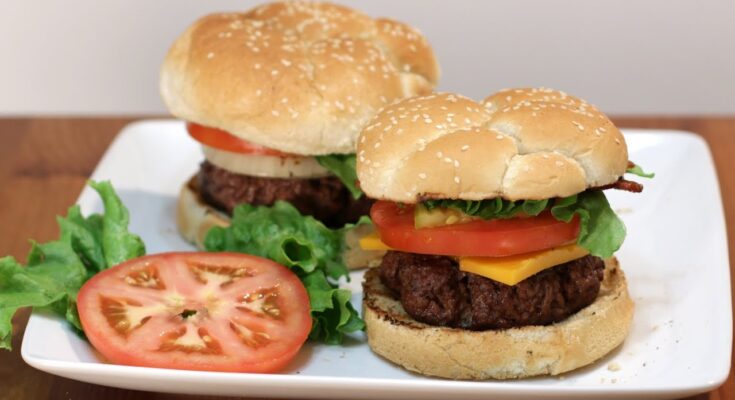Burger Patty Recipe: There’s nothing like a homemade burger patty. You get complete control over the flavors, the texture, and the quality of the ingredients. Plus, let’s be honest—homemade burgers just taste better.
In this guide, I’ll walk you through a foolproof method to create juicy, flavorful burger patties that will have your friends and family raving.
Ready to master the art of burger-making? Let’s get started!
Ingredients for the Perfect Burger Patty
The secret to a great burger starts with the ingredients. Here’s what you’ll need:
Essential Ingredients
- Ground beef (80/20 ratio recommended) – The ideal mix of fat and lean meat for juicy patties
- Salt and black pepper – The basics for flavor
- Garlic powder (optional) – Adds a subtle kick
- Onion powder (optional) – For extra depth of flavor
Optional Ingredients
- Chopped onions – Adds moisture and sweetness
- Shredded cheese – Perfect for stuffed or cheese-topped burgers
- Fresh herbs (parsley, thyme) – For a gourmet touch
Choosing the Right Meat
The type of meat you use can make or break your burger. Here’s what to consider:
- Fat-to-Lean Ratio: An 80/20 ratio (80% lean meat, 20% fat) is ideal for juicy, flavorful patties. Lower fat ratios (like 90/10) can result in dry burgers.
- Fresh vs. Frozen: Freshly ground beef gives you better control over texture and flavor.
- Alternatives: You can also use ground turkey, chicken, or plant-based meat substitutes if you prefer.
Essential Tools for Making Burger Patties
You don’t need a ton of fancy equipment, but a few key tools can make the process smoother:
- Mixing Bowl: For combining your ingredients
- Burger Press: Optional but helpful for forming uniform patties
- Grill or Pan: You’ll need one or the other for cooking
Step 1: Preparing the Ingredients
Before you start shaping patties, it’s crucial to prepare everything ahead of time. Here’s how:
- Chill Your Ingredients: Cold meat is easier to work with and holds together better.
- Measure Seasonings: Pre-measure your salt, pepper, and any additional spices to avoid over-seasoning.
- Prep Any Add-ons: If you’re adding chopped onions, garlic, or herbs, get them ready now.
Step 2: Mixing the Patty Mixture
Mixing the ground beef with seasonings can be tricky. You want the flavors evenly distributed without overworking the meat. Overmixing can lead to tough patties—definitely not what we want.
- Place the ground beef in a large mixing bowl.
- Sprinkle the seasonings evenly over the meat.
- Gently mix with your hands or a spoon until just combined.
Step 3: Forming the Patties
Now it’s time to shape the patties! Follow these tips for perfectly shaped burger patties:
- Divide the mixture into equal portions (about 4-6 ounces per patty).
- Roll each portion into a ball, then flatten it to about ½ to ¾ inch thickness.
- Press a shallow indentation into the center of each patty to prevent puffing up during cooking.
Step 4: Seasoning and Pre-Grill Preparation
You’ve mixed and shaped the patties. Now, it’s time to give them a final seasoning touch.
- Sprinkle a bit more salt and pepper on both sides of each patty.
- Let the patties rest for a few minutes to absorb the flavors.
- Lightly oil the grill or pan to prevent sticking.
Step 5: Cooking the Burger Patties
Time to cook! Whether you’re grilling or pan-searing, follow these steps for juicy results:
- Preheat your grill or pan: High heat helps create a perfect sear.
- Place the patties on the grill or pan: Cook for about 3-4 minutes on the first side.
- Flip once: Cook for another 3-4 minutes, depending on your desired doneness.
- Use a meat thermometer to check the internal temperature:
- Rare: 125°F
- Medium: 145°F
- Well-done: 160°F
Flipping and Monitoring the Patties
The key to a perfectly cooked burger patty is knowing when and how to flip it. Too early, and you’ll tear the patty apart. Too late, and you risk burning it.
When to Flip the Patties
- Timing: For a standard ½-inch patty, flip after 3 to 4 minutes of cooking on medium-high heat.
- Visual Cue: The edges of the patty should look browned and slightly cooked before flipping.
Avoiding Common Flipping Mistakes
- Don’t press down on the patty with your spatula. This squeezes out the juices, leading to dry burgers.
- Avoid excessive flipping. Once is enough! Let the patty cook undisturbed on each side for the best sear and flavor.
Checking Internal Temperature
- Use a meat thermometer to gauge the internal temperature. Aim for 160°F for well-done burgers or 145°F for medium.
Step 6: Adding Cheese (Optional)
What’s better than a juicy burger? A juicy burger with melty cheese!
Choosing the Right Cheese
- Classic Choices: American, cheddar, or Swiss cheese melt beautifully and are great for burgers.
- Gourmet Options: Brie, gouda, blue cheese, or pepper jack can take your burger to the next level.
When to Add the Cheese
- Add the cheese during the last minute of cooking. Place it on top of the patty, then cover the grill or pan with a lid to trap the heat and encourage melting.
Step 7: Resting the Burger Patties
Resist the urge to bite into the burger as soon as it’s done. Letting it rest is crucial to preserving its juices and flavor.
Why Resting Matters
When the patties are hot, the juices are concentrated in the center. Resting allows those juices to redistribute evenly throughout the patty.
How to Rest the Patties
- Remove the patties from the heat and place them on a clean plate.
- Cover loosely with foil and let them rest for about 3-5 minutes before serving.
Step 8: Assembling the Burger
Here’s where the fun begins—creating your perfect burger stack!
Choosing the Bun
- Classic Bun: Soft sesame seed or brioche buns are perfect choices.
- Toasted or Untoasted: Lightly toasting the bun adds a nice texture and helps prevent it from getting soggy.
Suggested Layering Order
- Spread sauces (mayo, ketchup, or mustard) on the bottom bun.
- Place lettuce, tomato, or onions on the bottom bun to protect it from the patty’s juices.
- Add the rested burger patty with melted cheese.
- Top with pickles, extra sauce, and the top bun.
Customization Ideas
- Add avocado slices, sautéed mushrooms, or jalapeños for extra flavor.
- Experiment with sauces—think chipotle mayo, garlic aioli, or barbecue sauce.
Common Burger Patty Mistakes to Avoid
To make sure your burgers turn out perfect every time, watch out for these common mistakes:
- Overhandling the Meat: Overworking the ground beef can lead to tough, chewy patties.
- Under or Overseasoning: Find the right balance—don’t be afraid to season generously, but keep it simple with salt and pepper as the base.
- Skipping the Resting Step: This often-overlooked step can make a world of difference in juiciness.
- Overcooking: Keep an eye on cooking times and temperatures to avoid dry patties.
Tips for Customizing Your Burger Recipe
Make your burgers uniquely yours with these creative ideas:
Unique Seasoning Blends
- Try adding smoked paprika, cumin, or Worcestershire sauce to the patty mixture.
- For an international twist, add curry powder or chili flakes.
Stuffed Burger Variations
- Place a piece of cheese inside the patty for a molten cheese surprise.
- Try stuffing the patty with caramelized onions or sautéed mushrooms.
Gourmet Toppings
- Upgrade your toppings with arugula, roasted red peppers, or truffle mayo.
- For a sweet-and-savory combo, add a slice of grilled pineapple or a drizzle of honey mustard.
FAQs about Burger Patty Recipe
What type of meat is best for making burger patties?
For the juiciest and most flavorful burger patties, a mix of ground chuck with a fat content of about 15-20% is ideal. This ensures that the patties are moist and tender once cooked.
How do I keep my burger patties from falling apart?
To keep your burger patties from falling apart, avoid overhandling the meat and do not overpack the patties. Additionally, chilling the patties in the refrigerator for about 30 minutes before grilling can help them hold their shape better.
Should I season my burger patties before cooking?
Yes, seasoning your burger patties before cooking can enhance their flavor significantly. Simple seasonings like salt and pepper can be added right before cooking, but for more flavor, you can mix spices and herbs into the meat when forming your patties.
How thick should I make my burger patties?
Aim for patties that are about ¾ inch thick. This thickness is ideal for achieving a nicely seared exterior with a juicy, fully cooked interior without the patties becoming too dry or burnt on the outside.
Can I make burger patties ahead of time?
Yes, you can prepare burger patties ahead of time. Shape the patties and layer them between pieces of parchment paper. Store them in the refrigerator for up to a day or freeze them for longer storage. Thaw in the refrigerator overnight before cooking.
How long should I cook my burger patties?
The cooking time for burger patties depends on their thickness and your desired doneness. Generally, for a ¾ inch thick patty, cook each side for about 4-5 minutes on medium heat for a medium-rare finish. Adjust the time if you prefer your burgers more or less done.
What is the best way to cook burger patties for a barbecue?
For a barbecue, grilling is the best method to cook burger patties. Make sure your grill is preheated and clean. Cook the patties on medium-high heat and avoid pressing down on them with a spatula, as this can cause them to lose their juices.
Conclusion
And there you have it—a step-by-step guide to creating the ultimate burger patties. By choosing the right ingredients, mastering your cooking technique, and getting creative with toppings, you’ll have a recipe that’s sure to impress. Remember, the beauty of homemade burgers is that you can customize them however you like. So, roll up your sleeves, fire up the grill, and enjoy the burger-making journey!



